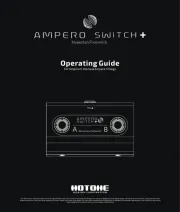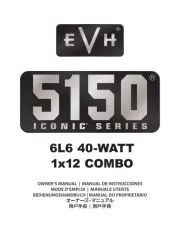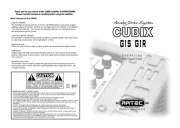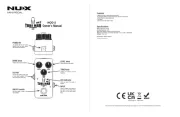Marshall JMD:1 Handleiding
Marshall
Gitaarversterker
JMD:1
Bekijk gratis de handleiding van Marshall JMD:1 (10 pagina’s), behorend tot de categorie Gitaarversterker. Deze gids werd als nuttig beoordeeld door 66 mensen en kreeg gemiddeld 4.9 sterren uit 33.5 reviews. Heb je een vraag over Marshall JMD:1 of wil je andere gebruikers van dit product iets vragen? Stel een vraag
Pagina 1/10

Owners Manual

From
Jim Marshall
I would like to take this opportunity to personally congratulate you on
choosing this JMD:1 amplifier from Marshall.
We pride ourselves on our ability to invent, innovate and create new
ways for guitarists to find their own sound, whether that be through
all-valve, solid-state or hybrid technologies.
First released in 1992, the JMP-1 pre-amp offered guitarists unrivalled
flexibility, with true Marshall tone at its heart. It proved to be a great
success! Ever since the JMP-1’s triumph, we have been eager to see
how technology could be pushed even further and, as a result, we are
pleased to introduce its successor, the JMD:1 Series.
The Marshall R&D team have always kept a keen eye (and of course
their ears) on new technologies, and have implemented them when they
were right for the product. Our number one rule - never sacrifice tone for
technology’s sake. Only now have all the components, state-of-the-art
technology and nearly 50 years of experience come together to create
this exciting amplifier range. The JMD:1 is the result of a unique
collaboration with our friends at SoftubeT M, leading to a true digital
pre-amp, integrated into a product that I am proud to see the Marshall
name on. Partnered with a traditional Marshall valve power amp, it
becomes the most flexible and first, totally programmable valve digital
hybrid amplifier series we have ever made. Never before has such a
variety of great quality tone been available in one product.
I would like to wish you every success with your new Marshall. Welcome
to the family.
Yours Sincerely,
Dr Jim Marshall OBE
Follow all instructions and heed all warnings
KEEP THESE INSTRUCTIONS !
* EUROPE ONLY - Note:
This equipment has been tested and found to comply with the requirements of the EMC Directive
(Environments E1, E2 and E3 EN 55103-1/2) and the Low Voltage Directive in the E.U.
* EUROPE ONLY - Note:
The Peak Inrush current for the 50 Watt is 25 amps.
The Peak Inrush current for the 100 Watt is 25 amps.
Note:
This equipment has been tested and found to comply with the limits for a Class B digital device, pursuant to part 15 of the FCC rules.
These limits are designed to provide reasonable protection against harmful interference in a residential installation. This equipment generates,
uses and can radiate radio frequency energy and, if not installed and used in accordance with the instructions, may cause harmful interference
to radio communications. However, there is no guarantee that interference will not occur in a particular installation. If this equipment does cause
harmful interference to radio or television reception, which can be determined by turning the equipment off and on, the user is encouraged to try
to correct the interference by one or more of the following measures:
*
Reorient or relocate the receiving antenna.
*
Increase the separation between the equipment and the receiver.
*
Connect the equipment into an outlet on a circuit different from that to which the receiver is connected.
*
Consult the dealer or an experienced radio/TV technician for help.

2
JMD:1 – Time Line and Amp History
As previously stated the JMD:1 Series incorporates the
tones and characteristics of a variety of Marshall
amplifiers and FX pedals. This section provides a brief
history of all these products.
1. 1959
Initially manufactured from the mid to late 60s, this
legendary amplifier embodies the very essence of the
vintage Marshall sound.
Nicknamed 'The Plexi' due to the gold plexiglas front
panel, the 1959 was born when The Who’s guitarist, Pete
Townshend, approached Marshall in the mid ’60s and
asked Jim to build him a ‘weapon’ that would allow him to
play so loud that he wouldn’t be able to hear what the
members of the audience were saying, should they have
the sheer audacity to talk whilst he was performing! Jim
and his team obliged, and within weeks of Pete’s request
one of rock’s most instantly recognisable icons was born -
the 100 Watt Marshall stack.
Although production of the 1959 continued long after the
1960s, the end of the Plexi-era began in ’69 when gold
anodised aluminium was introduced for the front panels.
The original 'Plexis' have therefore become extremely
rare and highly prized pieces of rock history.
2. 1974
Despite Marshalls iconic status as the creator of the stack,
Marshall has also produced a number of undeniable icons
in the amplifier combo world. Initially created back in 1966,
the 1974 is a compact all-valve combo. The 1974 was
designed to be an affordable valve amplifier for the
masses and soon gained a healthy reputation. Set in a top
loaded cabinet, this compact 18 Watt combo housed a
single 12”speaker, which meant not only was it
immensely portable but it also had the power and punch.
Utilising EL84 valves, the overall feel and tone of the 1974
is inherently different to an EL34 amp.
Separated into two separate channels, each with two
inputs for low and high sensitivity, the 1974 originally
came in two options, Reverb or Tremolo. The standard
channel for the amplifier had just single tone and volume
controls whilst the other channel had additional controls to
adjust the effect applied. The 2004 re-issue of the 1974
featured only the more popular Tremolo option and, as
with the original unit, these additional controls for this
channel adjust both the speed and intensity of the effect
to the guitarists taste. The re-issue, like all of Marshalls
re-issued vintage amplifiers, was a painstaking recreation
of the original unit and even features the same valve
tremolo circuitry.
Featured twice in the JMD:1, the 1974 provides part of
the new sound created for the Crunch Vintage mode
where it couples the tonal qualities of the 1974 with the
EQ of a monster 1959. The 1974 is also used for the
Crunch Full pre-amp mode, where the 1974’s sustain and
clarity of individual notes is used, demonstrating why the
1974 is still popular with guitarists to this day in its new
1974X re-issue format.
3. JCM800 2203
The 2203 is quite simply one the most important
amplifiers Marshall has ever created. Evolving from the
previously mentioned 100 Watt Plexi head, it was the first
to house a Master Volume (MV) control. This ground-
breaking feature allowed the pre-amp to distort fully
without having to turn the amp up to ten, providing thick
overdriven tone at a fraction of the volume. First available
in the mid ’70s, it wasn't until 1981 that the version of the
2203 we know today was unleashed as part of the mighty
JCM800 series. This straightforward, yet highly versatile,
single channel monster, immediately found favour with
the rapidly growing heavy metal scene that dominated
much of the ’80s. The wide ranging tonal palette of the
2203 saw it prove just as popular in the Brit Pop and
Grunge laden ’90s and remains the benchmark by which
all modern rock amps are judged. The 2203 has provided
the muscle behind countless rock and metal legends and
has appeared twice as a modified signature model. The
2203 provides the JMD:1 with two pre-amp options.
Crunch Classic delivers a raw edgy tone, one that
optimises the Marshall crunch sound. The Overdrive
Deep pre-amp pairs the 2203 with Marshall Bluesbreaker
pedal topology, creating hot-rodded tones the way they
should be.
4. The Guv'nor Distortion Pedal
Launched in the 1980’s, the original Guv’nor (so called as
this is Jim Marshall’s nickname) became a classic
footpedal known for high quality distortion tones. Much
loved by pros, semi-pros and amateurs alike, the Guv’nor
1
2
3
4
6
Product specificaties
| Merk: | Marshall |
| Categorie: | Gitaarversterker |
| Model: | JMD:1 |
Heb je hulp nodig?
Als je hulp nodig hebt met Marshall JMD:1 stel dan hieronder een vraag en andere gebruikers zullen je antwoorden
Handleiding Gitaarversterker Marshall

11 Januari 2025

19 Juni 2023

14 Juni 2023

5 Juni 2023

22 Mei 2023

11 Mei 2023

11 Mei 2023

8 Mei 2023

3 Mei 2023

3 Mei 2023
Handleiding Gitaarversterker
- Hughes & Kettner
- Digitech
- Palmer
- API Audio
- Empress Effects
- Valeton
- Budda
- Two Notes
- Hartke
- Roland
- Electro Harmonix
- Dimavery
- Fender
- Suhr
- ART
Nieuwste handleidingen voor Gitaarversterker

4 September 2025

14 Augustus 2025

5 Augustus 2025

4 Augustus 2025

4 Augustus 2025

31 Juli 2025

29 Juli 2025

28 Juli 2025

18 Juli 2025

17 Juli 2025